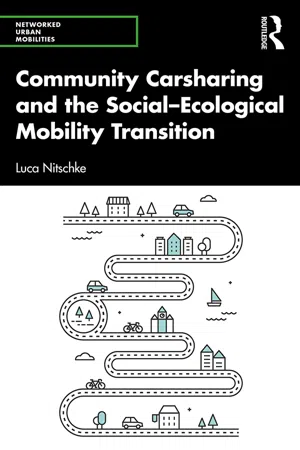
- 228 pages
- English
- ePUB (mobile friendly)
- Available on iOS & Android
Community Carsharing and the Social–Ecological Mobility Transition
About This Book
This book investigates how practices of community carsharing are influencing everyday mobility. It argues that hegemonic practices of automobility are reconfigured through practices of community carsharing, thereby challenging capitalist mobilities in the realm of everyday life.
Through a detailed empirical study of practices of community carsharing and its practitioners in the rural regions around Munich, Germany, this book reveals how the practice contributes to the emergence of alternative automobile practices, meanings, identities and subjectivities. It also explores the embedding of automobility into its ecological context, the connection of function and community in practices of community carsharing and the changing of ownership relations through a process of commoning mobility. This reconfiguration of everyday practices of automobility takes place through processes of everyday resistance, re-embedding and commoning, and ultimately results in the emergence of an alternative mobility culture, thereby facilitating the dissemination of an alternative common sense of community carsharing.
This book on community carsharing provides a valuable insight into carsharing in rural settings and exemplifies how carsharing specifically, and sharing mobilities in general, can contribute to a social–ecological mobility transition. The work will be of particular interest to scholars and practitioners working in mobility studies and mobilities.
Frequently asked questions
Information
1 Capitalist mobilities, sharing mobilities and the need for reconfiguring the everyday
Car cleaning parties and fighting a virus
Rosa hands me a sponge and the spray for the removal of stains on fabrics: “Just look at the seats and if you see a stain, put some spray on it, leave it for a short while and then scrub it off with the sponge.” There are three cars with five seats each, so I quickly start my work. Everybody else attending the car-cleaning party also is eagerly working on their task. Robert and his two kids are cleaning the windows, windshields and door seals. Rosa is removing coarse soiling from the wheel rims and the outer body. Rudi and Kurt are taking turns in vacuuming the interior space and everybody has an eye on the waiting line for the car wash, which is much busier than I expected for a sunny Saturday afternoon in early November. While cleaning cars can be perceived as a dull task, doing it together in a group and perhaps also because of the curious looks from the other people at the gas station, cleaning the cars feels like more than just a duty and attains meaning and even a tinge of fun.While cleaning, the attendees also use the time to inspect the condition of the cars. We find a few scratches that are new and discuss where they might be coming from: a door unintentionally slammed into some obstacle or carelessly loading or unloading something into or from the trunk. Nobody seems to be impressed by these marks and there is no search for somebody who can be held responsible. I personally wouldn’t be upset about scratches on a car, but I am wondering a bit about the fact that the others aren’t either. Most people who care about cleaning their car thoroughly would also tend to care about the scratches, one would assume. But as nobody seems to really care, I also decide not to and continue with cleaning the seats. After finding some more scratches Rudi provides an explanation for why they don’t care about the scratches: “It is only an object of utility. This doesn’t matter.” A car is supposed to be used to transport things and that necessarily leads to signs of usage, nothing to worry or be upset about. Robert nods in agreement and adds: “As long as the car is safe to drive, these beauty errors don’t bother anybody. I certainly don’t mind and if somebody does they should get their own car.”That Saturday, after cleaning three of the eight cars, the small group meets up in a café for some warm drinks, cake and ice cream – “the social and more important part of the cleaning party” according to Rosa and the participants. At earlier parties the members managed to clean more than just three cars and due to the low participation Rosa is organizing an additional appointment for the following weekend for the shirkers in order to clean the other five cars before winter. When I asked Robert if there are always only four people at these parties, he said: “It depends. Sometimes there are more, sometimes nobody shows up. But it is a pity that there aren’t more people. Well, I think they just don’t get the social aspect of the carsharing association.”
Table of contents
- Cover
- Half Title
- Series Page
- Title Page
- Copyright Page
- Dedication
- Table of Contents
- List of illustrations
- Foreword
- Preface
- 1. Capitalist mobilities, sharing mobilities and the need for reconfiguring the everyday
- 2. Empirical introduction: Investigating community carsharing
- 3. Reconstituting automobility: Changing the meanings of the car and (auto)mobility
- 4. Re-embedding automobility: Ecological critique and counter-hegemonic practice
- Interlude: The collective and organizational character of everyday life
- 5. “We do it together for us”: Community, collective identity and social re-embedding
- 6. Commoning mobility: Community carsharing and changing ownership
- 7. Community carsharing and the social–ecological mobility transition
- Index